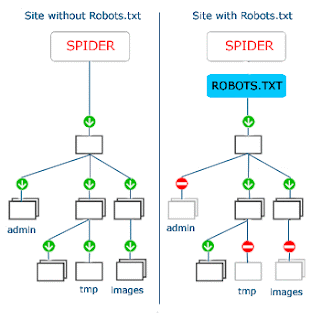Robots.txt file is a very important file for seo if
you want to have a good ranking in major search engines, many websites don't
offer this file. A Robots.txt file is helpful to keep out unwanted
search engine spiders like email retrievers, image strippers, etc. It defines
which paths are off limits for spiders to visit. This is useful if you want to
hide some personal information or some secret files from search engines.
 What is Robots.txt
What is Robots.txt
Robots.txt file is a special text file that is
always located in server's root. Robots.txt file contains restrictions for Spiders,
telling them where they have permission to read. A Robots.txt is like defining rules for search engine
spiders (robots) what to follow and what not to. It should be noted that Web
Robots are not required to respect Robots.txt files,
but most well written Web Spiders follow the rules you define.
How to Create Robots.txt
The format for the robots.txt file is special. It consists of records.
Each record consists of two fields: a User-agent line and one or more Disallow:
lines. The format is:
<Field> ":" <value>
The robots.txt file should be created in Unix line ender
mode! Most good text editors will have a Unix mode or your FTP client *should*
do the conversion for you. Do not attempt to use an HTML editor that does not
specifically have a text mode to create a robots.txt file.
User-agent
The User-agent line specifies
the robot. For example:
User-agent: googlebot
You may also use the wildcard
character "*" to specify all robots:
User-agent: *
You can find user agent names
in your own logs by checking for requests to robots.txt. Most major search engines
have short names for their spiders.
Disallow
The second part of a record consists of Disallow: directive
lines. These lines specify files and/or directories. For example, the following
line instructs spiders that it can not download contactinfo.htm:
Disallow: contactinfo.htm
You may also specify directories:
Disallow: /cgi-bin/
Which would block spiders from your cgi-bin directory?
There is a wildcard nature to the Disallow directive. The
standard dictates that /bob would disallow /bob.html and /bob/indes.html (both
the file bob and files in the bob directory will not be indexed).
If you leave the Disallow line blank, it indicates that ALL
files may be retrieved. At least one disallow line must be present for each
User-agent directive to be correct. A completely empty Robots.txt file is the
same as if it were not present.
White Space & Comments
Any line in the robots.txt that begins with # is considered to be
a comment only. The standard allows for comments at the end of directive lines,
but this is really bad style:
Disallow: bob #comment
Some spider will not
interpret the above line correctly and instead will attempt to disallow
"bob#comment". The moral is to place comments on lines by themselves.
White space at the beginning of a line is allowed, but not recommended.
Disallow: bob #comment
Examples
The following allows all
robots to visit all files because the wildcard "*" specifies all
robots.
User-agent: *
Disallow:
This one keeps all robots
out.
User-agent: *
Disallow: /
The next one bars all robots
from the cgi-bin and images directories:
User-agent: *
Disallow: /cgi-bin/
Disallow: /images/
This one bans Rover dog from
all files on the server:
User-agent: Rover dog
Disallow: /
This one bans keeps googlebot
from getting at the personal.htm file:
User-agent: googlebot
Disallow: personal.htm














2 comments:
superb ne ...
Nice..
Movers Packers in Delhi
Post a Comment